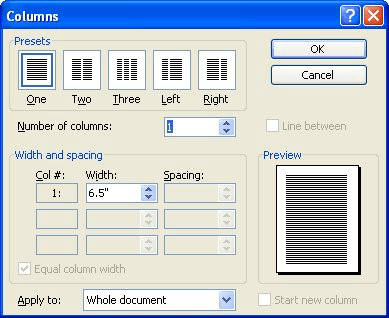Please Note: This article is written for users of the following Microsoft Word versions: 97, 2000, 2002, and 2003. If you are using a later version (Word 2007 or later), this tip may not work for you. For a version of this tip written specifically for later versions of Word, click here: Vertical Lines in Word.
Written by Allen Wyatt (last updated April 23, 2022)
This tip applies to Word 97, 2000, 2002, and 2003
For some documents you may have a need to insert vertical lines. There are actually three or four different ways you can do this in Word. The actual method you choose depends on your document needs and which appeals to you the most. The first method involves using the Drawing toolbar:
You can continue to draw more lines using this same technique, or you can simply close the drawing toolbar by again clicking on the Drawing tool on the regular toolbar.
The second method involves using bar tab stops. You can see how these appear by following these steps:

Figure 1. The Tabs dialog box.
If you have multiple columns in your document and you want vertical lines between the columns, you can follow these steps:

Figure 2. The Columns dialog box.
The final way to create vertical lines is to use tables. While this may seem a bit convoluted, it will work great for small sections of text. To use this method, follow these general steps:
WordTips is your source for cost-effective Microsoft Word training. (Microsoft Word is the most popular word processing software in the world.) This tip (1061) applies to Microsoft Word 97, 2000, 2002, and 2003. You can find a version of this tip for the ribbon interface of Word (Word 2007 and later) here: Vertical Lines in Word.

Discover the Power of Microsoft Office This beginner-friendly guide reveals the expert tips and strategies you need to skyrocket your productivity and use Office 365 like a pro. Mastering software like Word, Excel, and PowerPoint is essential to be more efficient and advance your career. Simple lessons guide you through every step, providing the knowledge you need to get started. Check out Microsoft Office 365 For Beginners today!
If you have a document with many graphics, you know that Word can sometimes be slow in displaying all those graphics. ...
Discover MoreIf you need to make sure that the graphics in a document are all scaled similarly, you'll love the macros presented in ...
Discover MoreNeed your hide some of the outside edges of a graphic? You can instruct Word to crop (or hide) those outside edges by ...
Discover MoreFREE SERVICE: Get tips like this every week in WordTips, a free productivity newsletter. Enter your address and click "Subscribe."
There are currently no comments for this tip. (Be the first to leave your comment—just use the simple form above!)
Got a version of Word that uses the menu interface (Word 97, Word 2000, Word 2002, or Word 2003)? This site is for you! If you use a later version of Word, visit our WordTips site focusing on the ribbon interface.
Visit the WordTips channel on YouTube
FREE SERVICE: Get tips like this every week in WordTips, a free productivity newsletter. Enter your address and click "Subscribe."
Copyright © 2025 Sharon Parq Associates, Inc.
Comments